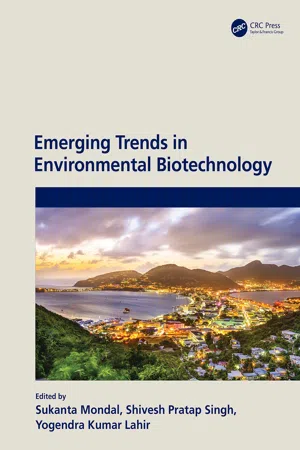
Emerging Trends in Environmental Biotechnology
- 298 pages
- English
- ePUB (mobile friendly)
- Available on iOS & Android
Emerging Trends in Environmental Biotechnology
About This Book
The environment is an all-encompassing component of the ecosystem of "Blue planet - the earth", made up of the hydrosphere, atmosphere and lithosphere. These three spheres have biotic and abiotic components which exhibit ecological homeostasis that provides the most appropriate survival chances for the members of biotic component and geochemical balance with abiotic components. This ecosystem is subjected to relatively harsh conditions, mostly created by the disastrous activities due to natural calamities and intentional and/or accidental anthropogenic activities. Biotechnology has become a potential tool to dissipate such environmental impacts because of the advancement it has undergone recently.
Emerging Trends in Environmental Biotechnology is an outstanding collection of current research that integrates basic and advanced concepts of biotechnology such as genomics, proteomics, bioinformatics, sequencing, and imaging processes to improvise and protect the environment. This book is particularly attractive for scientists, researchers, students, educators and professionals in environmental science, agriculture, veterinary and biotechnology science. The book will enable them to solve the problems about sustainable development with the help of current innovative biotechnologies such as recombinant DNA technology and genetic engineering which have tremendous potential for impacting global food security, environmental health, human and animal health and overall livelihood of mankind.
Features
-
- Presents easy-to-read chapters
-
- Information is presented in a very accessible and logical format
-
- Identifies and explores biotechnological approaches for environmental protection
-
- Encompasses biodegradation of hazardous contaminants, biotechnology in waste management, nanotechnology, and issues in environmental biotechnology research
Frequently asked questions
Information
1Environmental Biotechnology: An Overview
CONTENTS
1.1 Intruodction

| Microorganisms | Type | Degrading and Removal Capability |
|---|---|---|
| Pseudomonas putida | Aerobic bacteria | Toluene, naphthalene |
| Dechloromonas aeromatica | Aerobic bacteria | Perchlorate and aromatic compounds |
| Nitrosomonas europaea | Aerobic bacteria | These microorganisms are able to remediate ammonium and nitrate from industrial wastewater to control the eutrophication |
| Nitrobacter hamburgensis | Aerobic bacteria | |
| Paracoccus denitrificans | Aerobic bacteria | |
| Methylibium petroleiphilum | Aerobic bacteria | Methyl tetra-butyl ether (MTBE) |
| Deinococcus radiodurans | Aerobic bacteria | Ionic mercury and toluene in radioactive environment |
| Methylotrophs | Aerobic bacteria | Chlorinated aliphatic trichloro-ethylene, 1,2-dichloroethane |
| Bacillus subtilis, Bacillus amyloliquifaciens | Aerobic bacteria | Removal of heavy metals such as Cu, Ni, Pb, Hg |
| Phanerochaete chrysosporium | Aerobic fungi | Lignin of plant biomass, pesticides, polyaromatic hydrocarbons, PCB, dioxins, dyes, TNT, cyanide, azide, carbon tetrachloride, pentachloro-ethane. |
| Aspergillus niger, Penicillium spinulosum | Aerobic fungi | Removal of Cu, Cd, Zn |
| Rhizopus arrhizus, Saccharomyces cerevisiae | Aerobic fungi | Uranium |
- Treatment of the solid waste and wastewater by microorganisms
- Removal and cleanup of organic and inorganic pollutants at the site or in the lab by bioremediation
- Energy production from biomass
- Transformation of chemical compounds to control and protect the environment by native and genetically engineered microorganisms
- Biomonitoring of pollutants in soil, water and so on for environmental control
1.2 Biotechniques Used for Environmental Problems
1.2.1 Bioremediation
Table of contents
- Cover
- Half Title
- Title
- Copyright
- Dedication
- Contents
- Preface
- Acknowledgment
- Editors
- Contributors
- 1 Environmental Biotechnology: An Overview
- 2 Pollution and Pollution Control
- 3 Biotechnology in Waste Management
- 4 Role of Absorption and Adsorption in the Removal of Waste
- 5 Biotechnological Approach for Wastewater Management: Constructed Wetlands Is a Green Solution
- 6 Multi-Soil Layering System for the Treatment of Domestic Wastewater
- 7 Nanotechnology and Its Implications in the Environmental Biotechnology
- 8 Climate Change Impact on Livestock Reproduction
- 9 Biosurfactants and Their Applications in Environmental Cleanup
- 10 Biobased Fuel and Chemicals from Lignocellulosic Biomass—Prospects and Challenges
- 11 Impact of CRISPR-Based Gene Editing in Environmental Biotechnology
- 12 Biotechnological Approaches for Increasing the Production and Utilization of Natural Fibers for a Cleaner and Greener Environment
- 13 Sustainable Development in Environmental Biotechnology
- 14 Policies and Issues in Environmental Biotechnology Research
- 15 Enzymes in Environment Management
- 16 Health Issues and Environmental Biotechnology
- 17 Socioeconomic Status and Its Relation to Pollution
- 18 Gene–Environment Interaction and the Risk of Chronic Kidney Disease of Uncertain Etiology
- 19 Environmental Biotechnology: Public Perception
- 20 Biodegradation of Hazardous Contaminants and Pesticides
- Index